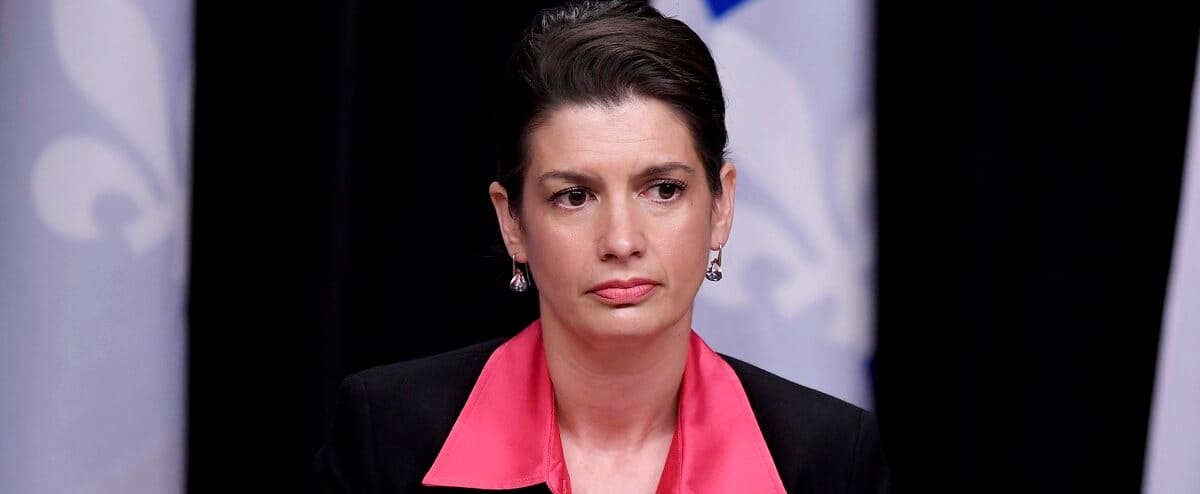Building a third “two-tube” link with a road section would have cost $10 billion, admitted Minister Geneviève Guilbault, who wants to convince motorists to abandon their cars with a tunnel reserved exclusively for public transport.
• Read also: 3rd link: projections took into account teleworking from April 2022
• Read also: 3rd link without cars: mayors and business people from the South Shore in good shape
• Read also: 3rd link: the Legault government abandons cars and relies on public transport
As reported by our Parliamentary Office, earlier this week, the Legault government officially buried its flagship promise to dig a road tunnel under the river to connect Quebec and Lévis.
It was alone, and without a timetable, cost or outline for the new version of her project, that the Minister of Transport and Sustainable Mobility appeared before the media to make the announcement. It was necessary to proceed in a “sober” way, explained Mr.me Guilbault saw the “disappointment” and the “sadness” of his fellow caquists in the region, including Bernard Drainville and Éric Caire (see other text).
Photo Stevens LeBlanc
The Minister of Transport and Sustainable Mobility, Geneviève Guilbault, appeared alone in front of the media, in the same room where the daily press briefings took place during the pandemic, and “where you were continually told of difficult decisions”, she observed, officially burying the promise of a 3rd road link.
In the light of traffic studies updated according to the effect of telework, “we have no data which would justify the establishment of a motorway tunnel between the two city centers”, confirmed Mr.me Guilbault.
From bank to bank, travel times in 2022 “have all decreased” compared to what was observed before the pandemic, even at peak times (see table). “The distribution of ridership and the way of getting around day to day is different from before the pandemic,” she explained.
For the Project Office, which will now work on a solution dedicated solely to public transport, this is yet another return to the drawing board, but “not quite from zero”, said Ms.me Guilbault.
If no cost has been specified, estimates for a 100% public transport tunnel and other options exist, but they are all redacted in the studies recently made public.
However, we learn that the route of a tunnel where electric buses or a tramway would circulate would extend from the Saint-Roch district to the Galeries Chagnon, in Lévis, over approximately 6 kilometers.
Overheated
Another “factor” that the government has taken into account is the overheating of construction costs.
Carrying out the two-tube project presented in April 2022, which was to cost a maximum of $6.5 billion, would have ultimately cost around “9.5, 10 billion $”, admitted Mr.me Guilbault.
“But I don’t want us to have the impression that we are saying: ‘It’s too expensive for Quebec, that means we don’t do it anymore.’ It’s not that. If there had been a need, if the figures had shown the need, we would have done it,” she said.
Modal shift
“I understand that there are people who are disappointed, because the current infrastructures are not ideal,” commented Prime Minister François Legault.
On the other hand, the addition of a third link dedicated to public transport will allow “a significant reduction” in travel time from one city center to another, which currently takes almost an hour by bus.
Minister Guilbault is convinced that a “really interesting, attractive, efficient, reliable, efficient, safe, etc. public transit alternative will make people want to give up the car,” argued Ms.me Guibault.
“The modal share of the car is increasing all the time in Quebec and on the South Shore. People are taking the car more and more, and it is not likely to be reversed if we do not have a public transport offer which is different and which is really attractive, ”she observed. .
Even with the previous version of his project, “by having really efficient public transport between our two shores (in one of the two tubes), we cannibalized the road tunnel”, observed the Minister of Transport and Sustainable Mobility.
- Listen to the Martineau-Dutrizac meeting with Richard Martineau at the microphone of Benoit Dutrizac on QUB-radio :
Some data justifying the abandonment of the road tunnel
- According to the routes analysed, the savings in travel time for public transport users through the tunnel (71%) would be greater than the travel times for car users through the tunnel (37%).
- According to the model, public transit ridership in 2036 with the construction of the tunnel would be around 3,400 rides during the morning rush hour, compared to around 1,500 rides in 2022, which would represent an increase of 126 %.
2019-2022 comparison of journey times
Quebec (Saint-Émile) to Lévis (Desjardins) (41.3 km)
AM 7 a.m. to 8 a.m.
- 2019: 45 mins.
- 2022: 34 mins.
- Gain: 11 min. (24%)
PM from 4 p.m. to 5 p.m.
- 2019: 58 mins.
- 2022: 47 mins.
- Gain: 11 min. (19%)
Lévis (Pintendre) to Quebec (Beauport) (41 km)
AM 7 a.m. to 8 a.m.
- 2019: 48 mins.
- 2022: 39 mins.
- Gain: 9 min. (18.7%)
PM from 4 p.m. to 5 p.m.
- 2019: 49 mins.
- 2022: 41 mins.
- Gain: 8 min. (16%)
Bellechasse to Saint-Roch (39.4 km)
AM 7 a.m. to 8 a.m.
- 2019: 61 mins.
- 2022: 51 mins.
- Gain: 10 mins. (16%)
PM from 4 p.m. to 5 p.m.
- 2019: 60 mins.
- 2022: 51 mins.
- Gain: 9 min. (15%)
Lévis Convention Center to Québec City Convention Center (26.4 km)
AM 7 a.m. to 8 a.m.
- 2019: 39 mins.
- 2022: 30 mins.
- Gain: 9 min. (23%)
PM from 4 p.m. to 5 p.m.
- 2019: 28 mins.
- 2022: 24 mins.
- Gain: 4 mins. (14%)



